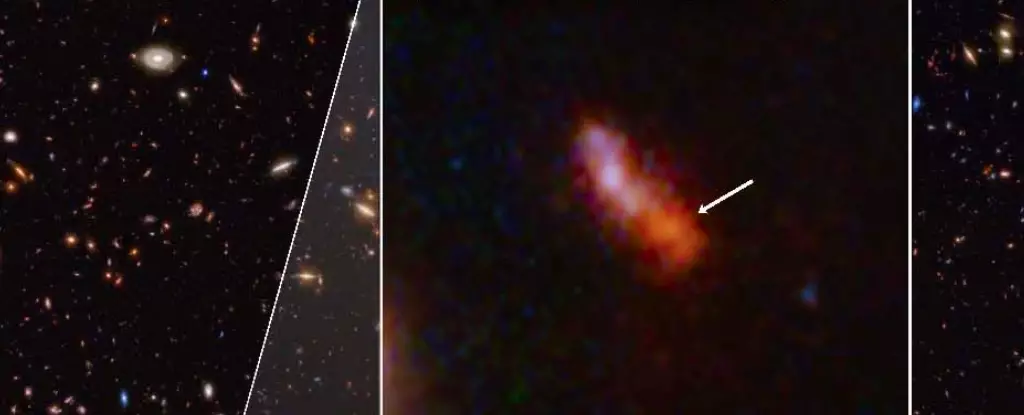The James Webb Space Telescope (JWST) has decisively transformed our understanding of the cosmos since its inception. With each newly illuminated corner of the universe, it provides fresh insights into the earliest epochs of galactic formation. Its most recent triumph is the extraordinary detection of a galaxy merely 280 million years after the Big Bang—dubbed MoM-z14. This discovery signals not only a remarkable achievement in astronomical observation but also a tipping point in our comprehension of galaxy evolution during the universe’s infancy.
Unprecedented Capabilities
The JWST’s prowess stems from its significantly larger mirror compared to its predecessors. While the Hubble Space Telescope operates with a 2.4-meter mirror and the Spitzer Space Telescope with an 85 cm mirror, the JWST boasts a formidable 6.5-meter mirror designed to gather infrared light from the farthest reaches of space. Such advancements in detector technology and mirror size allow the JWST to pierce through the dense veil that obscures early universal history, revealing tantalizing traces of ancient stars that would have remained hidden otherwise. The observational power of this state-of-the-art instrument not only surpasses expectations but also raises deeper questions about the origin and evolution of galaxies.
Unraveling the Cosmic Narrative
With its novel design and capabilities, the JWST has expanded the boundaries of our observational horizon, and the results are staggering. Prior to its launch, astronomers had speculated about the existence of galaxies during the universe’s formative years, yet many were surprised by the sheer number of bright galaxies detected at redshifts greater than z=10. MoM-z14, with its astonishingly high redshift of z=14.4, pushes the observational frontier back to a mere 280 million years post-Big Bang. This is truly a groundbreaking moment for the field, as astronomers had previously anticipated finding only a sparse handful of galaxies at such early epochs.
The implications of this discovery are far-reaching. Researchers emphasize the unexpected abundance of bright galaxies, which not only challenges pre-existing theories but also stimulates critical discussions around how these celestial bodies formed and evolved in the harsh conditions of the early universe.
Exploring Chemical Signatures
One of the research papers detailing this incredible finding, “A Cosmic Miracle: A Remarkably Luminous Galaxy at zspec = 14.44 Confirmed with JWST,” authored by a team led by Rohan Naidu, highlights the intriguing chemical composition of MoM-z14. Notably, the galaxy’s nitrogen-to-carbon ratio exceeds that of our own Sun, suggesting that it harbors stars formed in environments akin to ancient globular clusters found associated with the Milky Way. This observation raises the possibility that early galaxies like MoM-z14 were breeding grounds for supermassive stars—an assertion supported by theoretical predictions about the conditions in the early universe.
Such discoveries are pivotal as they provide a glimpse into the processes that governed the initial formation of galaxies. By examining the chemical compositions and abundance patterns within these early galaxies, astronomers can infer how stars coalesced and evolved in the primordial universe, creating connections that span cosmic history.
Understanding Morphology Through Chemistry
Another surprising dimension of the research is how morphology, or the physical form of a galaxy, correlates with its chemical makeup. MoM-z14’s observation suggests a framework in which galaxies exhibit varying structures—some appearing as compact point sources, while others take on a more extended form. This bimodal distribution links morphology with chemical abundance patterns, revealing potential evolutionary pathways that govern galaxy formation.
As the JWST continues to unveil ancient galaxies, it has uncovered distinct classes of objects, including strongly nitrogen-emitting sources that offer insights into the varied evolutionary narratives of early cosmic formations. This presents an opportunity for researchers to link past stellar environments to modern galaxy compositions, illustrating a direct line connecting the early universe to galaxies we observe today.
The Future Awaits
The wait for the JWST was prolonged, yet the payoff has been monumental. Each discovery adds a stroke to the canvas of cosmic history, illuminating how galaxies have evolved over billions of years. The tantalizing hints presented by MoM-z14 and its ilk foreshadow more revelations to come, particularly as upcoming telescopes, such as the Roman Space Telescope, promise to reveal an even broader array of ancient galaxies.
The JWST stands not merely as a tool of observation—as a powerful beacon of innovation, it continues to chart a new course in our quest to unravel the universe’s earliest epochs. With findings that not only ignite curiosity but reshape fundamental understanding, the JWST invites humanity to look deeper and dream bolder about the fabric of the cosmos that envelops us.

